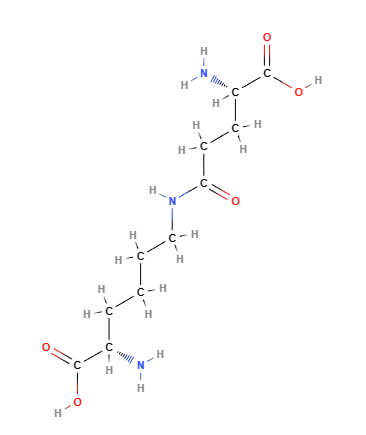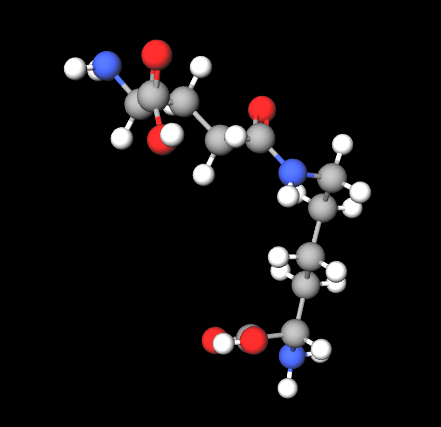![]() Dipeptide-9
Dipeptide-9
Rating : 7
| Evaluation | N. Experts | Evaluation | N. Experts |
|---|---|---|---|
| 1 | 6 | ||
| 2 | 7 | ||
| 3 | 8 | ||
| 4 | 9 | ||
| 5 | 10 |
0 pts from Al222
| Sign up to vote this object, vote his reviews and to contribute to Tiiips.Evaluate | Where is this found? |
| "Descrizione" about Dipeptide-9 by Al222 (20718 pt) | 2024-May-08 11:26 |
| Read the full Tiiip | (Send your comment) |
Dipeptide-9 is a chemical compound, a synthetic peptide, and a molecule composed of glutamic acid and lysine..
Peptides are substances consisting of two or more amino acids linked together by a linear chain. Synthetic peptides can be generated as copies of protein fragments by incorporating non-proteinogenic amino acids and modified so as to also increase the proteolytic stability of the molecules. Dipeptides are composed of two amino acids connected by a peptide bond.
What it is used for and where
Dipeptide-9 is a synthetic peptide commonly included in skincare products. It is known for its regenerative and moisturizing properties, helping to boost collagen production and strengthen the skin's structure. These properties can help reduce the appearance of wrinkles and fine lines, making Dipeptide-9 a valuable ingredient in anti-aging formulations.
Cosmetics
- Skin conditioning agent. It is the mainstay of topical skin treatment as it has the function of restoring, increasing or improving skin tolerance to external factors, including melanocyte tolerance. The most important function of the conditioning agent is to prevent skin dehydration, but the subject is rather complex and involves emollients and humectants that can be added in the formulation.
- Humectant. Hygroscopic compound used to minimise water loss in the skin and to prevent it from drying out by facilitating faster and greater absorption of water into the stratum corneum of the epidermis. The epidermis is the most superficial of the three layers that make up human skin (epidermis, dermis and hypodermis) and is the layer that maintains hydration in all three layers. In turn, the epidermis is composed of five layers: horny, the most superficial, granular, spinous, shiny, and basal. Humectants have the ability to retain the water they attract from the air in the stratum corneum and have the function of moisturising the skin. They are best used before emollients, which are oil-based.
- Hair conditioning agent. A significant number of ingredients with specific and targeted purposes may co-exist in hair shampoo formulations: cleansers, conditioners, thickeners, matting agents, sequestering agents, fragrances, preservatives, special additives. However, the indispensable ingredients are the cleansers and conditioners as they are necessary and sufficient for hair cleansing and manageability. The others act as commercial and non-essential auxiliaries such as: appearance, fragrance, colouring, etc. Hair conditioning agents have the task of increasing shine, manageability and volume, and reducing static electricity, especially after treatments such as colouring, ironing, waving, drying and brushing. They are, in practice, dispersants that may contain cationic surfactants, thickeners, emollients, polymers. The typology of hair conditioning agents includes: intensive conditioners, instant conditioners, thickening conditioners, drying conditioners. They can perform their task generally accompanied by other different ingredients.
Medical
Tripeptides and dipeptides have proven useful in biomedical applications (1) and for sensitive skin (2) and have demonstrated antioxidant activity (3).
 |  |
Molecular Formula C11H21N3O5
Molecular Weight 275.30 g/mol
CAS 17105-15-6
UNII O19B8F457C
Nikkaji J407.179D
Synonyms:
GGEL peptide
epsilon-(gamma-Glutamyl)-lysine
References_____________________________________________________________________
(1) Santos S, Torcato I, Castanho MA. Biomedical applications of dipeptides and tripeptides. Biopolymers. 2012;98(4):288-93. doi: 10.1002/bip.22067. PMID: 23193593.
Abstract. Peptides regulate many physiological processes, acting at some sites as endocrine or paracrine signals and at others as neurotransmitters or growth factors, for instance. These molecules represent a major evolution in medical and industrial fields, as it is becoming mandatory to design and exploit molecules that do not necessarily fit the description of classical drug classes. The list of peptides with potential biomedical applications is huge and is growing each year. These biomedical applications range from uses as drugs to flavor-active peptides as ingredients in natural health products, nutraceuticals and functional foods. Among the peptide family, dipeptides and tripeptides are very appealing for drug discovery and development because of their cost-effectiveness, possibility of oral administration, and simplicity to perform molecular structural and quantitative structure-activity studies. Our objective is to review different actual and future uses of dipeptides and tripeptides as well as the major advances and obstacles in this growing area.
(2) Resende DISP, Ferreira MS, Sousa-Lobo JM, Sousa E, Almeida IF. Usage of Synthetic Peptides in Cosmetics for Sensitive Skin. Pharmaceuticals (Basel). 2021 Jul 21;14(8):702. doi: 10.3390/ph14080702.
Abstract. Sensitive skin is characterized by symptoms of discomfort when exposed to environmental factors. Peptides are used in cosmetics for sensitive skin and stand out as active ingredients for their ability to interact with skin cells by multiple mechanisms, high potency at low dosage and the ability to penetrate the stratum corneum. This study aimed to analyze the composition of 88 facial cosmetics for sensitive skin from multinational brands regarding usage of peptides, reviewing their synthetic pathways and the scientific evidence that supports their efficacy. Peptides were found in 17% of the products analyzed, namely: acetyl dipeptide-1 cetyl ester, palmitoyl tripeptide-8, acetyl tetrapeptide-15, palmitoyl tripeptide-5, acetyl hexapeptide-49, palmitoyl tetrapeptide-7 and palmitoyl oligopeptide. Three out of seven peptides have a neurotransmitter-inhibiting mechanism of action, while another three are signal peptides. Only five peptides present evidence supporting their use in sensitive skin, with only one clinical study including volunteers having this condition. Noteworthy, the available data is mostly found in patents and supplier brochures, and not in randomized placebo-controlled studies. Peptides are useful active ingredients in cosmetics for sensitive skin. Knowing their efficacy and synthetic pathways provides meaningful insight for the development of new and more effective ingredients.
(3) Ozawa H, Miyazawa T, Burdeos GC, Miyazawa T. Biological Functions of Antioxidant Dipeptides. J Nutr Sci Vitaminol (Tokyo). 2022;68(3):162-171. doi: 10.3177/jnsv.68.162. PMID: 35768247.
Abstract. In the history of modern nutritional science, understanding antioxidants is one of the major topics. In many cases, food-derived antioxidants have π conjugate or thiol group in their molecular structures because π conjugate stabilizes radical by its delocalization and two thiol groups form a disulfide bond in its antioxidative process. In recent years, antioxidant peptides have received much attention because for their ability to scavenge free radicals, inhibition of lipid peroxidation, chelation of transition metal ions, as well as their additional nutritional value. Among them, dipeptides are attracting much interest as post-amino acids, which have residues in common with amino acids, but also have different physiological properties and functions from those of amino acids. Especially, dipeptides containing moieties of several amino acid (tryptophan, tyrosine, histidine, cysteine, and methionine) possess potent antioxidant activity. This review summarizes previous details of structural property, radical scavenging activity, and biological activity of antioxidant dipeptide. Hopefully, this review will help provide a new insight into the study of the biological functions of antioxidant dipeptides.
| Sign up to vote this object, vote his reviews and to contribute to Tiiips.EvaluateClose | (0 comments) |
Read other Tiiips about this object in __Italiano (1)
Component type: Chemical Main substances: Last update: 2024-05-08 11:12:30 | Chemical Risk: |


